|
Have a safe day!
Tuesday, Oct. 19
3:30 p.m.
DIRECTOR'S COFFEE BREAK - 2nd Flr X-Over
THERE WILL BE NO ACCELERATOR PHYSICS AND TECHNOLOGY SEMINAR TODAY
Wednesday, Oct. 20
3:30 p.m.
DIRECTOR'S COFFEE BREAK - 2nd Flr X-Over
4 p.m.
Fermilab Colloquium - One West
Speaker: Giacomo Mauro D’Ariano, University of Pavia
Title: Physics as Information Theory
Click here for NALCAL,
a weekly calendar with links to additional information.
Upcoming conferences |
|
Tuesday, Oct. 19
- Breakfast: Bagel sandwich
- Tomato bisque soup
- Lemon pepper club
- Beef fajitas
- Korean garlic chicken
- Grilled chicken Caesar salad wrap
- Assorted sliced pizza
- Rio Grande taco salad
Wilson Hall Cafe Menu
|
|
Wednesday, Oct. 20
Lunch
- Rouladen
- Spaetzel
- Dilled baby carrots
- Apple walnut cake
Thursday, Oct. 21
Dinner
- Crab cakes w/ red pepper mayonnaise
- Medallions of beef
- Potato cups
- Sauteed zucchini
- Grand Marnier Souffle
Chez Leon Menu
Call x3524 to make your reservation. |
|
|
Introduction
From Quantum Diaries, Oct. 15, 2010
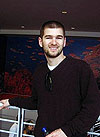 |
| John Felde |
Editor's note: This is the first Quantum Diaries post from new blogger John Felde. Felde was the first graduate student to join the collaboration for the proposed Long-Baseline Neutrino Experiment. Read his bio here.
Hello Quantum Diaries. My name is John Felde, and I am a new blogger. I am a Graduate Student at the University of California, Davis studying neutrino oscillations. Since these blogs are meant to reflect the daily life of particle physicists I thought I would introduce UC Davis in my first post. It is my impression that outside of Northern California, UC Davis is not really all that well known by the general public, mostly since we don't have a good football team. In the physics community we are more well known given our involvement in CDF at Fermilab, and CMS at the LHC. Here is a little bit about my town, and university.
UC Davis was founded in 1905 as an extension of UC Berkeley offering farming and agricultural related degrees. In 1959 UC Davis was formally established as an independent campus of the University of California system. Now, the university if made up of four colleges and six professional schools offering 102 undergraduate majors, and 82 graduate programs. In 2009 the student enrollment reached 32,153. Fortunately, UC Davis has the largest campus of the UC's with 5,300 acres (1 acre ~ 4,000 m2).
Read more
|
Work on stairs shows value of employee suggestions
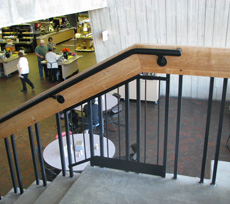 |
The atrium stairs to the second-floor crossover are getting a new, safer look. |
If you’ve ever doubted that work suggestions go anywhere other than into limbo, all you have to do is check out the stairs leading from the cafeteria to the second-floor cross over in Wilson Hall.
You’ll see the beginnings of a new raised handrail, a kick plate and metal slates. While the work adds a nice, aesthetic touch, its real contribution is to safety. A Fermilab employee pointed out that a small child could slip between the widely spaced vertical rails between the steps and handhold. The employee suggested eliminating the gaps, and potential for a fall, by slipping in a few extra rails. FESS thought that was a great idea and started work about a month ago.
The improvement prompted additional safety measures, including the kick plate, which prevents pens or other loose items from dropping off the steps and onto the dining tables below. The new raised, round handrail allows for a firmer grip. This handrail design will continue down the steps leading to Ramsey Auditorium.
Improvement work should finish by mid-November. |
Fermilab renews ISO and OHSAS certifications
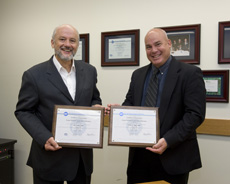 |
On Oct. 14, Director Pier Oddone presented certificates to Department of Energy Fermi Site Office Acting Manager Mark Bollinger. |
Fermilab earned re-registration of International Organization for Standardization 14001 and Occupational Health and Safety Assessment Series 18001 in recognition for the laboratory’s environmentally sound management practices.
“It’s not just that we got recertified,” Oddone said. “When they look at us, they judge whether we are mature in the way we’ve approached this and that the improvements are responsive to the previous analysis. I think they found that we have done a very good job in building this into the culture.”
|
Fermilab builds pioneering accelerator facility
From DOE Pulse, Oct. 11, 2010
DOE's Fermi National Accelerator Laboratory has started phase II of the construction of a new accelerator test facility to advance the development of superconducting radio-frequency technology. SRF cavities, which operate at -456 degrees Fahrenheit to eliminate electrical resistance, will be critical to the next generation of particle accelerators.
Fermilab is using $52.7 million in funding from the American Recovery and Reinvestment Act to advance its SRF program. The new facility, which will occupy three buildings and host a 460-foot-long test accelerator, will be the first of its kind in the United States. Phase I of the test facility construction began in March 2010. Fermilab will use the facility to test SRF cryomodules, validate the SRF manufacturing capability of vendors from U.S.industry, and conduct experiments with electron beams.
Read more
|
|
|
An important week
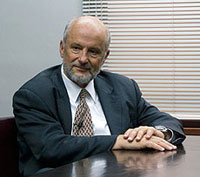 |
| Fermilab Director Pier Oddone |
Last week was notable for the FRA Board of Directors meeting on the 14 and 15 and the Particle Physics Project Prioritization Panel meeting on the 15 and 16.
We were fortunate to have both the DOE Director of the Office of Science, Bill Brinkman, and the Director General of CERN, Rolf Heuer, attend the FRA Board meeting. The discussions on the future of particle physics in the US, the CERN-Fermilab collaboration today and in the future, the plans for future global facilities and their governance were greatly enriched by Bill Brinkman's and Rolf Heuer's participation. We are grateful that they took time from their overloaded schedules to come to Fermilab.
While Rolf Heuer was here at Fermilab, we signed a letter of intent to work towards an agreement on future collaboration on the superconducting RF technology that underlies megawatt proton sources and lepton colliders. In the past we have signed laboratory-to-laboratory agreements between CERN and Fermilab, in consultation with DOE, where existing overarching agreements allowed us to have such lab-to-lab agreements. For new agreements with a laboratory like CERN, which is an international treaty organization, these agreements have to be cleared beyond DOE in the State Department through a more lengthy procedure. In the interim, while we work with the machinery of government, we have signed a letter of intent to work towards such a full and proper agreement.
The P5 meeting took place in Washington, D.C. The first morning was devoted to various presentations outlining all the issues to be considered in making a recommendation on the proposed Tevatron extension: the physics case, the impacts on the rest of the program, and the status and projections for the LHC. We have made all the materials that Fermilab and the collaborations working at Fermilab provided to P5 available in a public website so that our colleagues in the community can read what we presented. The rest of the meeting on Friday afternoon and Saturday was devoted to discussions of P5 in executive session -- P5 members and agency people only -- to prepare the recommendation to its parent committee, the High Energy Physics Advisory Panel. We will not know anything about the recommendation until P5 presents its report to HEPAP on October 26.
|
U.S. Embassy in India's Kulkarni tours Fermilab
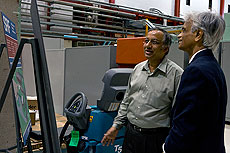 |
| Fermilab scientist Shekhar Mishra gave a tour on Oct. 6 of Fermilab's SRF Accelerator Test Facility. Satish V. Kulkarni, former science advisor to the U.S. ambassador to India.
Kulkarni is currently
at the Office of Vice President, Georgetown University, Washington. |
|
|